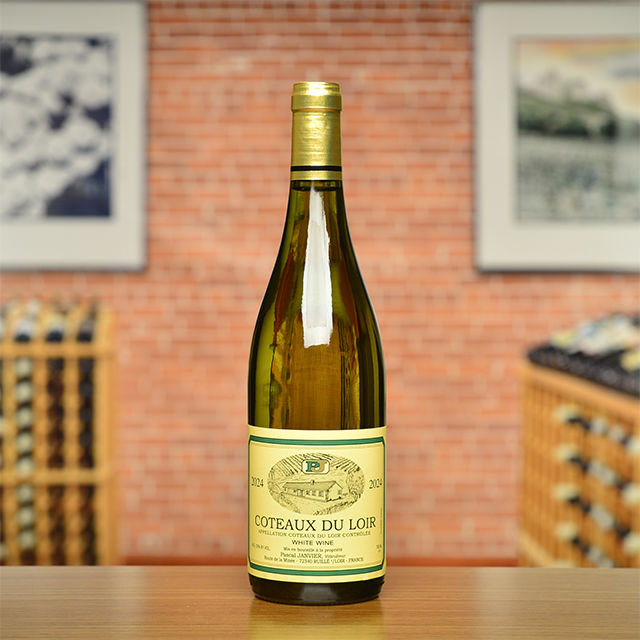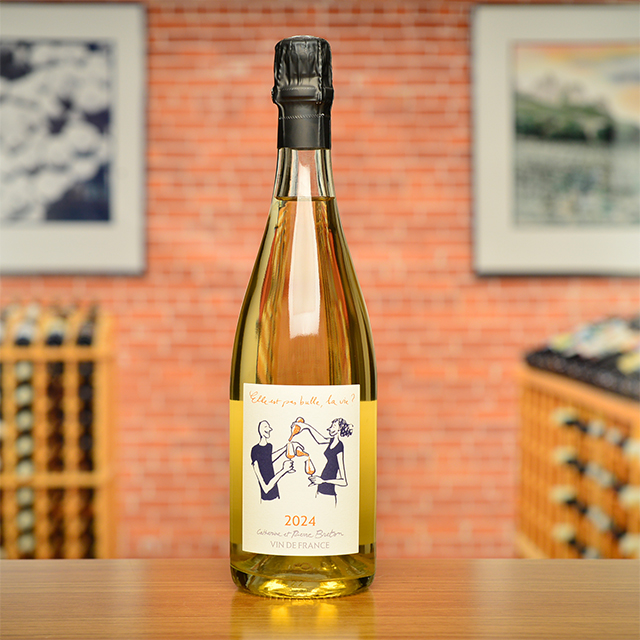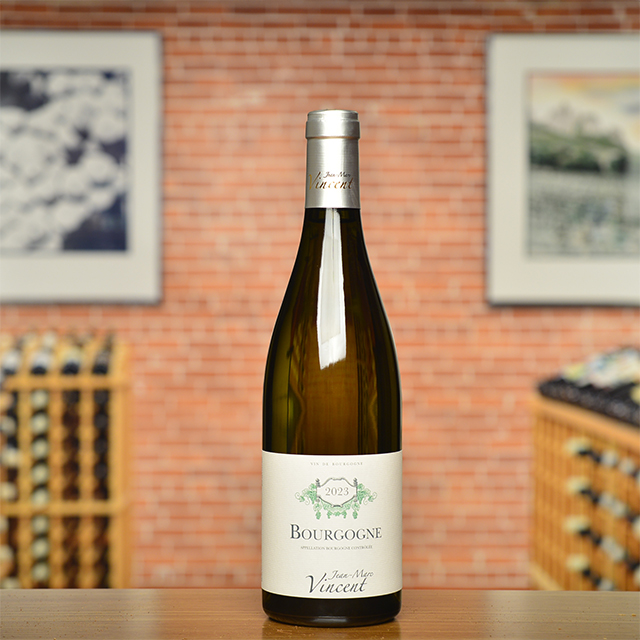Notify me
2018 Vin de France Rouge Grolleau/Cabernet Franc
Grange Saint-Sauveur
Alice Gitton-Pouponneau grew up in Le Thoureil, a charming village on the Loire between Angers and Saumur. Today, along with her husband, Antoine Pouponneau, she farms the sloping vineyard parcel that was essentially her backyard playground. This idyllic site, which faces the lazily meandering river, enjoys perfect southeast exposure and the moderating effect of the water. The old trunks of Grolleau and Cabernet Franc are clearly very happy, soaking up the sunshine and gorgeous views while sending deep roots into the soils of clay, limestone, and silex.
Since taking oversight of the vineyard, Alice and Antoine have applied biodynamic farming methods and plowed it with a horse. After a natural fermentation, the wine rested for 18 months in demi-muids before an unfiltered bottling. The beauty and energy of the site comes through with total transparency: the fruit is concentrated, deep, and pure, suggesting wild brambles and tart blackberries, along with an earthy, spicy component and hints of cedar. It has the levity to offer immediate pleasure, along with the complexity and structure to age well for a few years. At KLWM, we are thrilled to add this talented couple’s first cuvée to our diverse lineup of Loire reds.
—Anthony Lynch
| Wine Type: | red |
| Vintage: | 2018 |
| Bottle Size: | 750mL |
| Blend: | Grolleau Noir, Cabernet Franc |
| Appellation: | Vin de France |
| Country: | France |
| Region: | Loire |
| Producer: | Grange Saint-Sauveur |
| Winemaker: | Alice Gitton-Pouponneau and Antoine Pouponneau |
| Vineyard: | Planted in early 1980s, .65 ha |
| Soil: | Clay, limestone |
| Aging: | Élevage for 18 months in 1-3 year old demi-muids (400-600 liter) before aging 12 months in bottle |
| Farming: | Biodynamic (practicing) |
| Alcohol: | 12.5% |
More from this Producer or Region

2020 Vin de France Rouge Grolleau/Cabernet Franc “Clandestine”
France | Loire
A lovely combination of Grolleau Noir and Cabernet Franc, there seems to be a synergistic effect elevating both grapes to create a juicy, spicy, refreshing whole.

2024 Val de Loire Sauvignon Blanc “Unique”
France | Loire
Lime blossoms delivered via a lightning bolt of minerally refreshment.

2021 Vin de France Rosé Grolleau/Cabernet Franc “Les Arceaux”
France | Loire
Intensely dry and mineral, the structured Les Arceaux is a bottle to pair with a meal rather than to drink as an apéritif.

2022 Vin de France Rouge “Le Martray”
France | Loire
The new vintage shows great freshness and brightness, making me think of tart berries picked in the forest just a touch below full ripeness.

2024 Coteaux du Loir Blanc
France | Loire
Exotically perfumed with hints of guava, musk, and clove, it finishes dry and quite flinty.

2020 Vin de France Rouge Cabernet Franc “Huguette”
France | Loire
Huguette is a silky, peppery Cabernet Franc from vines over a century in age.

2019 Vin de France Rouge Grolleau/Cabernet Franc “Clandestine”
France | Loire
A lovely combination of Grolleau Noir and Cabernet Franc, there seems to be a synergistic effect elevating both grapes to create a juicy, spicy, refreshing whole.

2024 Vin de France Brut Nature “Elle est pas bulle la vie?”
France | Loire
Delicious and honest naturally sparkling Chenin, bottled with no dosage and no sulfur.

2020 Chinon “Les Varennes du Grand Clos”
France | Loire
With floral aromas and fine-grained tannins, it already showcases its charms.

2021 Vin de France Blanc “Chenin Centenaire”
France | Loire
Fermented and aged in barrel and bottled unfiltered, it features a delightful kiss of oak on the long, bracing, mouth-watering finish.
About The Producer
Grange Saint-Sauveur
Grange Saint-Sauveur’s wines are the first KLWM imports bearing Antoine Pouponneau’s name on their labels, but the connection with the Anjou native runs much deeper. Antoine worked as cellar manager at La Tour du Bon in Bandol from 1994 to 2006—his first job following enology studies in Dijon—then served a long tenure in Corsica as enologist at Clos Canarelli. His approach as a consultant is radically opposed to that of most enologists: a devout enthusiast of biodynamic farming and wild yeast fermentation, Antoine relies on his expertise in microbiology to create wines of character and identity via natural methods. His talents have earned him several prestigious clients over the years, as the likes of Cheval Blanc, Latour, and many others have sought his services to produce low-intervention, terroir-driven wines.
About The Region
Loire

The defining feature of the Loire Valley, not surprisingly, is the Loire River. As the longest river in France, spanning more than 600 miles, this river connects seemingly disparate wine regions. Why else would Sancerre, with its Kimmeridgian limestone terroir be connected to Muscadet, an appellation that is 250 miles away?
Secondary in relevance to the historical, climatic, environmental, and cultural importance of the river are the wines and châteaux of the Jardin de la France. The kings and nobility of France built many hundreds of châteaux in the Loire but wine preceded the arrival of the noblesse and has since out-lived them as well.
Diversity abounds in the Loire. The aforementioned Kimmeridgian limestone of Sancerre is also found in Chablis. Chinon, Bourgueil, and Saumur boast the presence of tuffeau, a type of limestone unique to the Loire that has a yellowish tinge and a chalky texture. Savennières has schist, while Muscadet has volcanic, granite, and serpentinite based soils. In addition to geologic diversity, many, grape varieties are grown there too: Cabernet Franc, Chenin Blanc, Sauvignon Blanc, and Melon de Bourgogne are most prevalent, but (to name a few) Pinot Gris, Grolleau, Pinot Noir, Pineau d’Aunis, and Folle Blanche are also planted. These myriad of viticultural influences leads to the high quality production of every type of wine: red, white, rosé, sparkling, and dessert.
Like the Rhône and Provence, some of Kermit’s first imports came from the Loire, most notably the wines of Charles Joguet and Château d’Epiré—two producers who are featured in Kermit’s book Adventures on the Wine Route and with whom we still work today.
More from Loire or France
2024 Savennières “Cuvée Spéciale”
Château d’Epiré France | Loire
2023 Reuilly Pinot Noir
Domaine de Reuilly France | Loire
2021 Bourgueil “La Dilettante”
Catherine & Pierre Breton France | Loire
2024 Val de Loire Sauvignon Blanc “Unique”
Domaine du Salvard France | Loire
2023 Quincy “Vieilles Vignes”
Domaine Trotereau France | Loire
2024 Vin de France Brut Nature “Elle est pas bulle la vie?”
Catherine & Pierre Breton France | Loire
2021 Vin de France Rosé Grolleau/Cabernet Franc “Les Arceaux”
Grange Saint-Sauveur France | Loire
2024 Quincy
Domaine Trotereau France | Loire
2021 Chinon “Les Varennes du Grand Clos”
Charles Joguet France | Loire
2024 Vouvray “Les Fondraux”
Champalou France | Loire
2024 Coteaux du Loir Blanc
Pascal Janvier France | Loire
Vouvray Brut
Champalou France | Loire
2024 Savennières “Cuvée Spéciale”
Château d’Epiré France | Loire
2023 Reuilly Pinot Noir
Domaine de Reuilly France | Loire
2021 Bourgueil “La Dilettante”
Catherine & Pierre Breton France | Loire
2024 Val de Loire Sauvignon Blanc “Unique”
Domaine du Salvard France | Loire
2023 Quincy “Vieilles Vignes”
Domaine Trotereau France | Loire
2024 Vin de France Brut Nature “Elle est pas bulle la vie?”
Catherine & Pierre Breton France | Loire
2021 Vin de France Rosé Grolleau/Cabernet Franc “Les Arceaux”
Grange Saint-Sauveur France | Loire
2024 Quincy
Domaine Trotereau France | Loire
2021 Chinon “Les Varennes du Grand Clos”
Charles Joguet France | Loire
2024 Vouvray “Les Fondraux”
Champalou France | Loire
2024 Coteaux du Loir Blanc
Pascal Janvier France | Loire
Vouvray Brut
Champalou France | Loire
Vintage Chart Mentality

Vintage Chart Mentality
Trust the great winemakers, trust the great vineyards. Your wine merchant might even be trustworthy. In the long run, that vintage strip may be the least important guide to quality on your bottle of wine.—Kermit Lynch




















